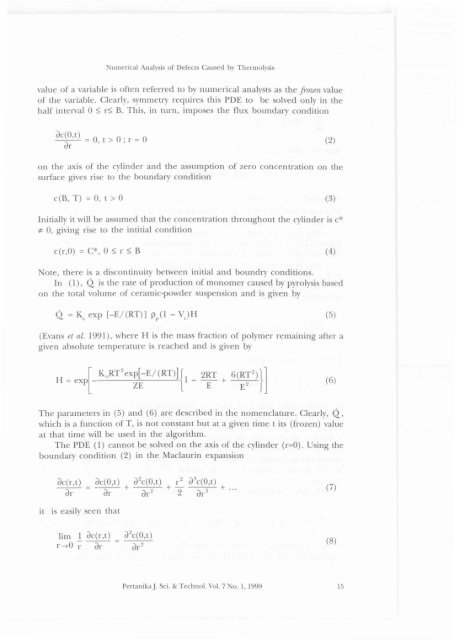Numerical Analysis of Defects Caused by Thermolysis in an Infinite ...
Numerical Analysis of Defects Caused by Thermolysis in an Infinite ...
Numerical Analysis of Defects Caused by Thermolysis in an Infinite ...
Create successful ePaper yourself
Turn your PDF publications into a flip-book with our unique Google optimized e-Paper software.
umerical <strong>Analysis</strong> <strong>of</strong> <strong>Defects</strong> <strong>Caused</strong> <strong>by</strong> <strong>Thermolysis</strong><br />
value <strong>of</strong> a variable is <strong>of</strong>ten referred to <strong>by</strong> numerical <strong>an</strong>alysts as the frozen value<br />
<strong>of</strong> the variable. Clearly, symmetry requires this PDE to be solved only <strong>in</strong> the<br />
half <strong>in</strong>terval °::; r::; B. This, <strong>in</strong> turn, imposes the flux boundary condition<br />
dC(O,t) = ° t > °.r = °<br />
dr ' ,<br />
(2)<br />
on the axis <strong>of</strong> the cyl<strong>in</strong>der <strong>an</strong>d the assumption <strong>of</strong> zero concentration on the<br />
surface gives rise to the boundary condition<br />
c(B, T) = 0, t > ° (3)<br />
Initially it will be assumed that the concentration throughout the cyl<strong>in</strong>der is c*<br />
;;f. 0, giv<strong>in</strong>g rise to the <strong>in</strong>titial condition<br />
c(r,O) = C*, 0::; r::; B (4)<br />
Note, there is a discont<strong>in</strong>uity between <strong>in</strong>itial <strong>an</strong>d boundry conditions.<br />
In (l), Q is the rate <strong>of</strong> production <strong>of</strong> monomer caused <strong>by</strong> pyrolysis based<br />
on the total volume <strong>of</strong> ceramic-powder suspension <strong>an</strong>d is given <strong>by</strong><br />
Q. = K exp [-E/(RT)] p (1 - V)H<br />
ope<br />
(5)<br />
(Ev<strong>an</strong>s et al. 1991), where H is the mass fraction <strong>of</strong> polymer rema<strong>in</strong><strong>in</strong>g after a<br />
given absolute temperature is reached <strong>an</strong>d is given <strong>by</strong><br />
KoRT2exP[-E/(RT)]{ 2RT 6(RT 2 )}]<br />
H = exp<br />
[<br />
ZE 1 - -E- + --'--E-'2,.-------'- (6)<br />
The parameters <strong>in</strong> (5) <strong>an</strong>d (6) are described <strong>in</strong> the nomenclature. Clearly, Q,<br />
which is a function <strong>of</strong> T, is not const<strong>an</strong>t but at a given time t its (frozen) value<br />
at that time will be used <strong>in</strong> the algorithm.<br />
The PDE (l) c<strong>an</strong>not be solved on the axis <strong>of</strong> the cyl<strong>in</strong>der (r=O). Us<strong>in</strong>g the<br />
boundary condition (2) <strong>in</strong> the Maclaur<strong>in</strong> exp<strong>an</strong>sion<br />
dc(r,t) dC(O,t) d 2 C(0,t) r 2 d 3 C(0,t)<br />
---=---+ +- + ...<br />
dr dr dr 2 2 dr 3<br />
(7)<br />
it<br />
is easily seen that<br />
lim 1 dc(r,t)<br />
r~O ~~<br />
(8)<br />
=<br />
Pert<strong>an</strong>ikaJ. Sci. & Techno!. Vo!. 7 No.1, 1999 15
















